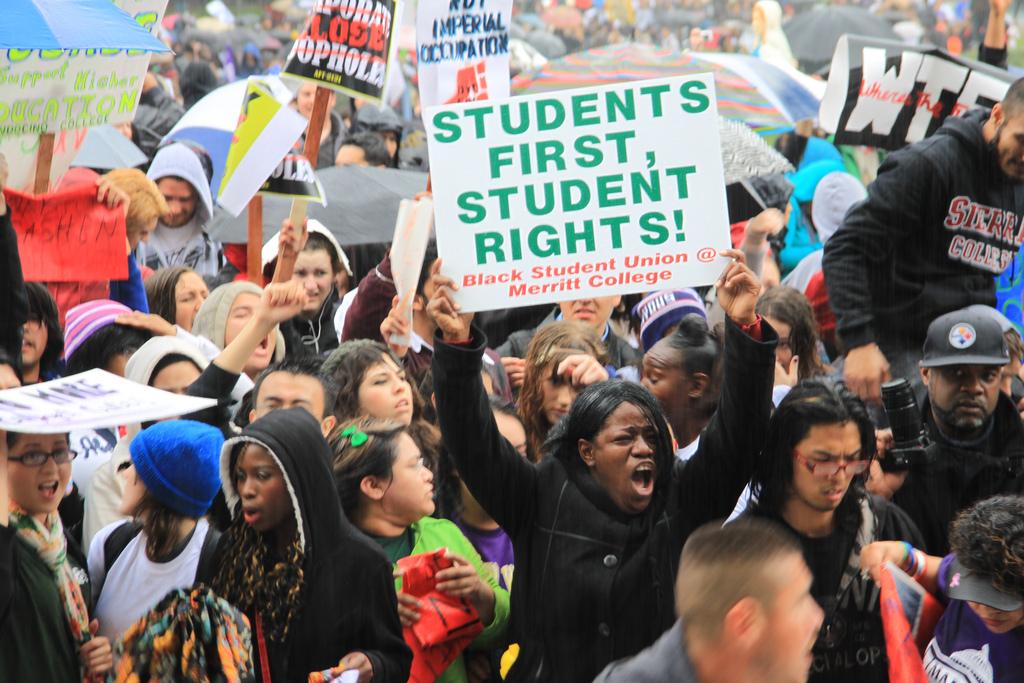Students fight for their rights
March 16, 2011
Thousands of California college students converged on the state capital March 14 for the March-in-March to protest fee hikes and budget cuts at state schools.
Students from California Community Colleges and State Universities from across the state, and as far away as San Diego, showed up in droves to voice their opinions.
“We are the future of this country and these cuts will prevent people from having the opportunity to have a better life,” said Noah Stiles, 19, communications major at San Jose State University.
Gov. Jerry Brown is proposing raising tuition at community colleges from $26 to $36 and cutting $400 million from their total budget. Cuts will also be made, if approved by voters in June, to the California State University and University of California systems, in an effort to make up for a $26 billion dollar deficit in the state budget.
Buses began to arrive at 5 a.m. at the staging area in front of the California Automobile Museum. Some schools such, as Santa Monica College, which brought over 150 students, had left the night before in order to participate.
Thirty-seven students from DVC went to participate in the march; far fewer than were anticipated by ASDVC. In attendance were ASDVC President Katerina Schreck and Secretary Alexis Terrill, ASDVC Advisor Yvonne Canada and others.
Debate over the day’s issues began early on the DVC bus.
Erik Von-Note, 27, fine-arts major, was in favor of fee hikes: “I want to preserve the same chances for others that I have been given. DVC helped give me direction.”
Nick Holmes, another current DVC student, disagreed, “any fee hike is unacceptable and an attack on the working class.”
All night drives as well as cold weather coupled with a continual downpour had little effect on student spirit, which was evident immediately upon arrival. Even before the march to the Capital began, students could be heard chanting through megaphones “students united will never be divided.”
“This is a good Start…students are using their collective powers to be heard,” said Christina Cline-Chavez of the No Cuts Coalition at Cal State Los Angeles. “We are here to let people know that if they are frustrated, they are not alone.”
Marchers continued lively chants all the way down the Capitol mall until they reached the State Capitol, where they were met by supporters. The crowd eventually filled the area from the steps to Ninth Street.
Assemblymember Marty Block, D-San Diego, was one of the speakers for a second year in a row. “So impressive, it shows how much students care,” Block said about the turnout.
Instead of fee hikes, Block hopes to pass an oil severance tax and continue temporary taxes to help fund higher education in California. “Students deserve to have a vote,” Block said. “Hopefully we’ll pressure [Republicans] to allow it to happen.”
According to the state’s Legislative Analyst’s Office, college fees could more than double if a temporary tax is not continued.
Assemblymember Warren T. Furutani, D-Los Angeles, was also on hand to speak to the crowd. “You are the ones that are the key to the future. We need people with advanced degrees to lead this country.”
The march and assembly on the Capitol was a comparatively peaceful protest to those that have happened in the Bay Area recently. Seventeen people were arrested at UC Berkeley on March 2 at a protest over budget cuts. There were no reported arrests or disturbances in Sacramento, though one person fainted in the crowd and was quickly attended to by emergency services.
Along with state assembly members, Student Senate for California Community Colleges President Alex Pader spoke to the crowd. “It was amazing, letting their voices be heard,” Pader said. When asked whether the protest will have an impact on state politicians, Pader responded “, it has to, college has to remain accessible to everyone in the state and we must invest in higher education.”
Over 2.9 million students attend over 112 community colleges in California; the nations largest system of higher education. Still, community colleges in California are set to remain the cheapest in the nation, even if tuition is increased from $26 a unit to $36 a unit.
Former ASDVC President Lindsay St. Hill, currently a member of the Student Senate for California Community Colleges, was among the crowd. “It was really exciting and there were a lot of positive remarks made. By heing here we’re getting the issues known,” St. Hill said. “We really hope to turn this around and help education for the future.”







































































